
Features
Operations
Devising the perfect YVR revival
In the summer of 1927, in the wake of his epic New York to Paris flight, Charles Lindbergh undertook a grand tour of North America, flying into more than 75 cities in his Spirit of Saint Louis.
July 7, 2014 By Paul Dixon
In the summer of 1927, in the wake of his epic New York to Paris flight, Charles Lindbergh undertook a grand tour of North America, flying into more than 75 cities in his Spirit of Saint Louis.
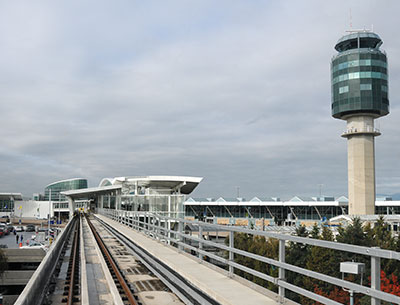 |
|
| The Canada Line rapid transit arrives at YVR. It’s the only airport in North America with a direct rapid transit link to downtown, 22 minutes away. PHOTO: Paul Dixon
|
When Vancouver’s city fathers extended an invitation, Lindbergh spurned it with the comment “there was no field fit to land on.” Well, if Lucky Lindy had been able to look into the future, he would have been pleasantly surprised to discover that by 2014 Vancouver’s airport would be named the best airport in North America for the fifth consecutive year by Skytrax, the international air travel rating and review service.
The World Airport Awards are based on 12.85 million customer nominations across 110 nationalities of air tra![]() vellers and, for 2014, included 410 airports worldwide. The survey evaluates customer satisfaction across 39 key performance indicators for airport service and product – from check-in, arrivals, transfers, shopping, security and immigration, through to departure at the gate.
vellers and, for 2014, included 410 airports worldwide. The survey evaluates customer satisfaction across 39 key performance indicators for airport service and product – from check-in, arrivals, transfers, shopping, security and immigration, through to departure at the gate.
So, is the Skytrax honour a big deal? That was the first question we put to Vancouver Airport Authority CEO Craig Richmond when Wings sat down with him for an exclusive interview shortly after this year’s award was announced. “It is a big deal,” Richmond said emphatically. “It’s not a Canadian thing to blow your own horn, but to be named, ‘the best airport in North America’ for the fifth year in a row is something else.”
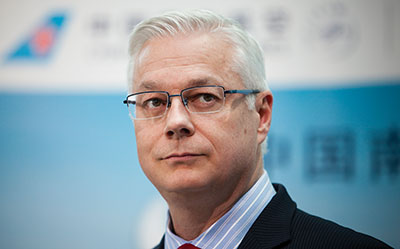 |
|
| YVR President and CEO Craig Richmond is looking to the future with both feet planted firmly on the ground. PHOTO: Ben Nelms, YVR
|
Richmond will tell you that all he ever wanted to do was to be around airplanes. Growing up in Kamloops, his first job was fueling aircraft at the local airport. He had his pilot’s license before he could drive a car. He joined the Royal Canadian Air Force (RCAF), and by age 20, he was flying CF-104 Starfighters and then CF-18 Hornets in Europe. The fall of the Berlin Wall gave him cause to re-evaluate his future and after 10 years with the RCAF, he left to pursue higher education. With an MBA from the University of Manitoba, he joined YVR in 1995. The rest, as they say, is history, culminating with his appointment as President and CEO in June 2013.
So, is there a direct connection between being a jet fighter pilot and CEO of a major airport? “Team work,” Richmond said without hesitation. “It’s the value of team work, of everybody pulling in the same direction. It might be a cliché, but it’s really true. You can do amazing things when no one cares who gets the credit. When you’re on squadron, you’re part of a big machine. Everyone knows their part, everyone’s working very hard, every job is important. That’s a lesson that you learn very quickly: you’re not much of a fighter pilot if your plane’s not fixed or armed or fueled, and you’re always working as part of a team and you have the entire base supporting you. This is the type of teamwork that has made Vancouver airport what it is.”
YVR emerges
After Lindbergh’s putdown, Vancouver city council bought 192 hectares on Sea Island, in the suburb of Richmond, and set about creating an airport. In 1931, the Vancouver Airport (and Seaplane Harbour) was opened to great fanfare as the first airfield in Canada with a hard-surface runway. It was reported by the Vancouver Province that more than 55,000 people showed up for the official opening over four days of festivities and the paper went on to enthuse that “Vancouver this week celebrates an important and a memorable occasion – the official opening of the $600,000 first unit of her airport, which, because of the city’s geographical position at the gateway to the Orient, is destined to play an increasingly effective role in international and inter-empire (sic) communication.”
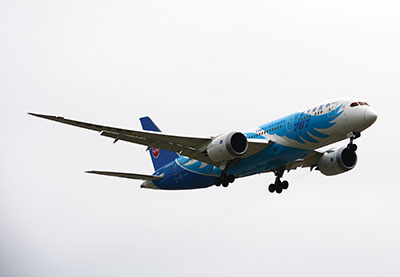 |
|
| A China Southern Boeing 787 Dreamliner arrives from Guangzhou, China. Asia’s largest airline operates five non-stop flights a week between YVR and Guangzhou. PHOTOs: Paul Dixon |
The unofficial tally for passengers in the first year of operation was a whopping 2,652, with the majority there to embark on sightseeing flights. On July 1, 1934, the first scheduled commercial aircraft, a United Airlines Boeing 247 from Seattle, arrived at the airport. And during the Second World War, the airport was home to RCAF Sea Island, part of the Commonwealth training program, as well as a large Boeing aircraft plant that built hundreds of PBY Catalina flying boats. The RCAF departed in the early-1960s, but Burkeville, a community of homes built for workers at the Boeing plant and named after the then president of Boeing, Stanley Burke, remains as a tightly knit community, fiercely proud of its roots, as the airport has expanded around it.
Following the Second World War, the airport grew along the south side of Sea Island on the middle arm of the Fraser River, but as air travel surged with the arrival of the commercial jetliner, a new main terminal was built at the present location in the middle of the island. The old terminal building is now part of Airport South, which provides a hub for the smaller coastal carriers, float planes, helicopters and executive aircraft operators. Opening in 1968, the new terminal building saw 1.9 million passengers pass through in the first year of operation, a huge increase over 1931, but a small fraction of the almost 19 million that came through in 2013.
In 1992, the Vancouver Airport Authority (VAA) took over operation of the airport from the federal government. VAA operates and manages the airport, but the land underneath it still belongs to the federal government. The 1968 terminal building was renovated and expanded as traffic increased, and in 1996 a new wing was finally opened, housing the international terminal as well as a new runway on the north side of terminal complex. In 2000, a further expansion of the international terminal saw the Fairmont YVR hotel incorporated into the terminal structure; the 400-room hotel was described by one reviewer as “not your average airport hotel,” underscoring the market that YVR is seeking to attract.
A look into the future
Richmond sees the future of YVR as the travel hub connecting Asia to all of North and South America. “We’re already doing that to the U.S., with the transit without visa program from four cities (in China) and two carriers,” he said. “If a Chinese national has a visa for the U.S. they don’t need one for Canada. We keep the traveller in a sterile, customs-controlled area between flights. It’s been very successful, with zero issues in over two years.”
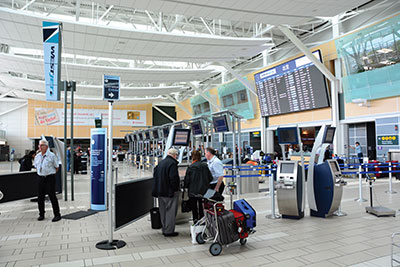 |
|
| YVR’s domestic departure level is open, spacious and bright. It’s a very inviting space for a busy international airport.
|
Richmond also maintains that expanding this program would potentially benefit travellers from a number of countries. “Why not other countries?” he asked. “If your ultimate destination is the U.S. and you have a Visa, then why not come through Vancouver? It’s a different world today from what it was 20 years ago. Ultimately we would like to do that between ourselves and South America. It’s an amazing geographical coincidence what a straight line there is between Rio de Janeiro, Vancouver and Beijing.”
As many as half a million metro Vancouver residents a year choose to drive 30 minutes south of the border to fly out of Bellingham or even the three hours to SeaTac rather than come to YVR, something that Richmond is acutely aware of. “It’s pretty tough,” he admits. “Bellingham has really exploited a niche with the ultra-low-cost carriers. They are in an entirely different regulatory environment with government support and people can take advantage of these cheap flights to Las Vegas and Hawaii. We cannot compete on price because the user-pay methodology up here is just more expensive. However, YVR is a full-service airport where you can fly all over the globe. I think you can access 49 per cent of the global economy directly in one flight from here. That’s not the Bellingham model.
“What really concerns me in terms of moving forward with our hub philosophy, is the bigger airports like Seattle, San Francisco, LA, Chicago, Calgary and Dallas, with new aircraft they want to be the new hubs between Asia and the Americas. There’s nothing written in stone that says we’re ‘it.’ Right now we are, we have the highest number of flights per week to Asia of any airport in North America, 75 flights a week. Many people don’t know that. We have more than LAX, more than San Francisco, more than New York, twice as many as Toronto. But, that’s not a given forever. That’s why we really have to be smart about what we invest in the terminal and how we do our business and go after more Asian carriers, not just China.”
The hub concept extends over a full 360 degrees. Last year, Icelandair initiated twice-weekly service from YVR to Iceland between May and October, offering simplified connections to Scandinavia and northern Europe. The domestic market holds promise as well, with a number of energy and resource-based mega-projects slated for northern B.C. in the early planning stages. YVR planners have that on their radar and Richmond said that they are already seeing an upward trend in traffic, “but if these big projects come off even half as big as people expect, we’ll have a lot of traffic to the North and up the B.C. coast.”
“We’re very well positioned, with our south terminal for the interior and up the coast,” Richmond said. “We are also starting to see direct jet service up to the north as well [replacing smaller turboprops]. We want to be ready for it and don’t want to get too far behind in our terminal capacity. One project underway right now is a high-speed baggage network connecting the domestic and international terminals, cutting the baggage transfer time in half. Above the baggage conveyor is a walkway for passengers that will allow them to connect from one terminal to the other without having to pass through security screening again.”
One area where Richmond thinks YVR can improve is in air cargo, with the realization that the newer aircraft such as the B777 and B787 have a much greater cargo capacity than the previous generation of aircraft. Increased capacity for belly cargo may obviate the need for dedicated freighters and increasing cargo makes routes more attractive for airlines.
“Over the next several years, we really want to kick up the volume on our cargo,” Richmond said. “It’s not easy, because a lot of cargo is outside of your control and depends on the community. We are looking at what we can do to boost our cargo, talking to all the freight forwarders and many small operators on this airport that are involved in cargo to understand what facilities they need in order to get bigger.”
The Eastern influence
As much of as the emerging middle class in China and other Asian countries will start to vacation overseas, it will also exert its new wealth by buying premium foods and other premium goods from abroad. This is another market that YVR hopes to exploit, by working with Canadian exporters to help them get their time-sensitive products to market to meet the growing demand, as Richmond explains.
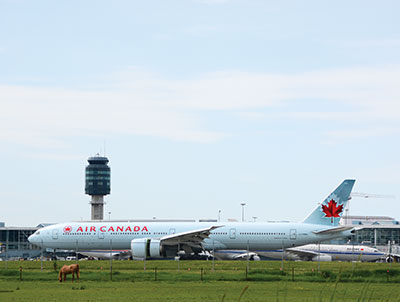 |
|
| YVR hopes larger aircraft such as the Boeing 787 and 777 will help improve cargo capacity at the airport.
|
“We work very closely with these industries to get them through customs, on the plane and overseas and then through the customs at the other end,” he said. “We also have a working agreement with Shanghai airport to work on their cargo, to try and cut down minutes of unnecessary delay. Dungeness from B.C. goes to market in Shanghai, it has 28 hours before it starts to go bad. That’s perishable, it can’t get left out in the heat or be caught in paperwork. Matsutake mushrooms from northern B.C. are worth $100 a kilo, but nothing if they spoil. Geoduck clams, spot prawns, crabs, tree fruits – freshness is everything and that’s why it’s shipped by air. B.C. cherries that sell for $2 a kilo in local stores can fetch $22 a kilo in China, a powerful incentive for growers. In 2014, B.C. cherry producers anticipate one-quarter of their crop will go to China.
As part of its commitment to working with customers, the Vancouver Airport Authority is a member of the B.C. Cherry Association. “You might wonder why,” said Richmond, “but it’s important for us to be tied in with our customers.” Another innovation has the cherry producers paying for two Chinese agricultural inspectors to come to B.C. to inspect the cherries as they are packed to expedite entry into China. It’s a great model from Richmond’s perspective, “and you have to wonder if we could do it for seafood as well.”
Good business practice
Business defines YVR, and in many ways YVR is a barometer for the economic well-being of Canada’s Pacific Coast. From the hospitality industry, through to the small business models in high-value agriculture and seafood to the multi-billion dollar mega-projects the business community, the airport is vital to the economy. To put a face to it, while the Airport Authority directly employs a workforce of just over 400 people, recent economic studies show almost 25,000 local jobs flow directly from airport activities and another 35,000 regional job in the broader context.
It’s come a long way since 1931, with that original 192 hectares expanding to more than 1,300 hectares, enabling it to meet its obligations to the traveller of today and the future, whether they are arriving in Vancouver as their destination or just passing through on their way to the other side of the world. The world comes here every day and they like what they see. I’m sure even Charles Lindbergh would be impressed.
Setting itself apart – YVR’s unique personality shines through in its art
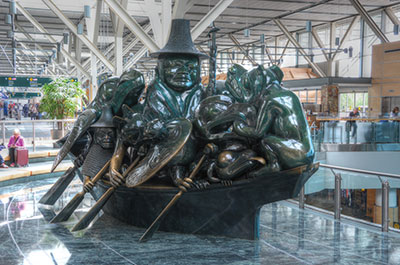
|
|
One of the keystones to establishing an airport’s identity or personality is the need for visitors to immediately be able to identify where they are in the world from the moment they step into the terminal. Over the past two decades, the Vancouver Airport Authority has amassed a collection of West Coast First Nations art that that is prominently displayed throughout the terminals. From Bill Reid’s masterpiece, Jade Canoe – The Spirit of Haida Gwaii that dominates the international departures level, there are works by mater artists Don Yeomans, Dempsey Bob, Robert Davidson, Richard Hunt and Susan Point that would be equally be at home in the world’s leading museums. The YVR Art Foundation fosters the development of young and emerging artists by providing scholarships and mentorship opportunities as well as exhibiting their works in the terminals alongside the work of the established masters. From the moment, when you enter YVR, arriving or departing, there is no question of where you are in the world as you are surrounded by the art form that has defined the west coast for thousands of years.